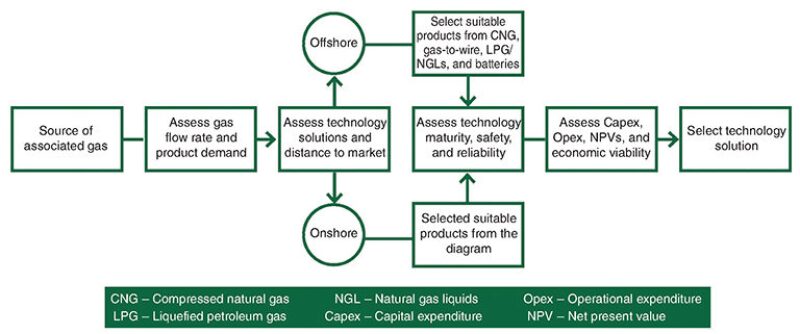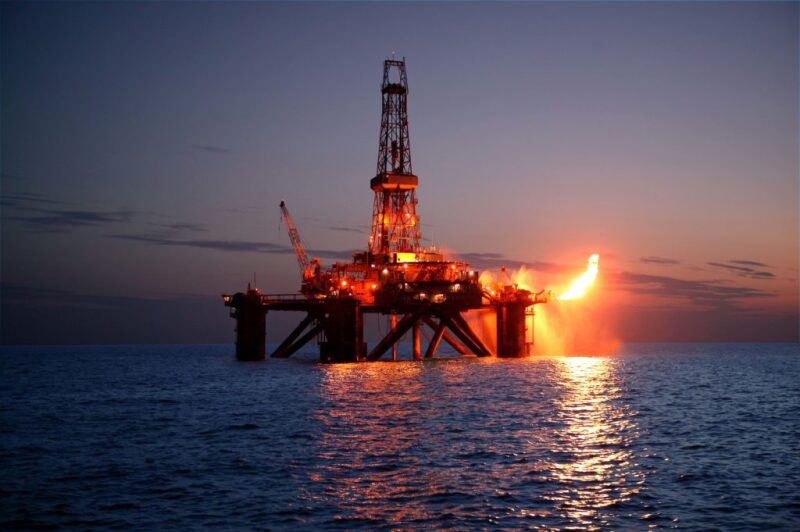Approximately 5% of world annual gas production is being flared or vented. This is equivalent to approximately 110–140 billion m3 (Bcm) of gas, and equates to the combined gas consumption of Central and South America in 2013.
The World Bank estimates that flaring 140 Bcm would cause more than 350 million tonnes of CO2 release into the atmosphere. If this could be harnessed for power, for example, it could produce 750 billion kW-hr/year, more than Africa’s entire annual consumption.
Capturing the flared or vented gas presents an opportunity for operators to reduce the environmental impact as well as provide an economic opportunity to generate an additional revenue stream. The World Bank’s “Zero Routine Flaring by 2030” initiative is calling on governments and companies to achieve this target within the next 15 years. To address both the need to end routine gas flaring and tackle climate change concerns, DNV GL has conducted research titled “Natural Gas Capture—Clean and Economic,” which examines the viability of alternative solutions and their revenue potential.
The conceptual study looked at four existing oil and gas facilities, onshore in North Dakota, Algeria, and Russia, and offshore Vietnam, which provided a variety of volumes and rates of gas being flared. This enabled the modeling of a range of diverse technologies on real locations and field conditions as most flaring occurs at either aging and/or remote locations.
Understanding the Challenges
A number of factors can affect the drive and desire to undertake a reduction in gas flaring. Existing solutions are mature for large-scale applications, but fewer technologies have been used commercially at a small scale. This is perhaps due to uncertainty in the industry about the technical and economic viability of capturing the gas at these levels.
Retrofits and transportation of recovered gas to processing facilities can be costly. Without a global cost penalty for emitted carbon there is seen to be little benefit to capture the flared gas, particularly in countries with developing economies. Similarly, different geographies conjure various technical, regulatory, and economic drivers and limitations. Access to funding to develop projects and the implementation of technologies is also a major factor.
Where there are carbon emissions regulations in place, there is obviously more incentive to capture the waste from gas flaring. In the US, there are limits in place for gas flaring that penalize operators through the curtailment of production for missing targets. As a result, new technologies are emerging with a variety of solutions. Since issuing its research, DNV GL has had a number of companies approach for assistance with the qualification process to help establish technologies in the market. The North Dakota Petroleum Council has set targets to reduce flaring. These were set to 26% by the fourth quarter of 2014, 23% by the first quarter of 2015, 15% by the first quarter of 2016, and 10% with the potential for 5% by the fourth quarter of 2020.
Technology Solutions
Gas flaring releases toxic components and greenhouse gases into the atmosphere that can have harmful effects on the health and wellbeing of local communities as well as contributing to climate change.
Proposed technology solutions are largely dependent on the flow rate, gas compositions, and distance to market, and the viability of different technologies will vary accordingly. During the conceptual study, our company considered the technoeconomic viability of 19 different conversion methods. These were considered at different flow rates, gas composition, and the distance to market. More than 150 suppliers/vendors and their technologies/methods were researched. By examining the most cost-effective ways of transporting and converting the gas into products of a higher value, they were able to identify opportunities to produce valuable product alternatives like ammonia, ethanol, gas-to-liquids, and hydrogen.
More novel techniques examined how to bring the market closer to the source of the flaring and the opportunities to capture in-situ. These included water desalination, gas-to-power, liquefied-petroleum-gas and natural-gas-liquids recovery, and carbon black. The technology solutions and means of transportation explored can also be applied to the following.
- Monetization of small-scale stranded gas fields
- Monetization of associated gas from extended well tests
- Resolving demands at remote areas where there is no infrastructure
- Capturing vented gas
In some North American shale regions that experience a lack of infrastructure and remote exploration and production activities, as much as 30% to 40% of gas is being flared. Installing transportation infrastructure is often costly and so looking at more economic and flexible solutions is highly attractive. As well as generating a valuable revenue stream, converting the gas can be highly beneficial to local populations. The fracturing process used in onshore shale gas extraction generates a great deal of produced water. Desalinization can clean that water and make it useable for local communities as a water source. Although some solutions might be immature for near-term implementation, current applications such as micro liquefied natural gas, compressed natural gas, natural gas hydrates, and conversion methods can deliver significant benefits, and are key in shale gas regions where regulations will drive flaring reductions.
Many of the novel techniques explored in the study, particularly for small-scale capture of natural gas, are maturing well in the US. Many are at the pilot stage at least. However, few are yet to be adopted elsewhere. Innovation is largely driven by the US shale industry, where many of the wells in North Dakota’s Bakken Basin are already implementing affordable alternatives to flaring through connections to existing gas-gathering networks. These handle associated liquids-rich gas from more accessible drilling areas which are being used to produce propane, methane, butane, natural gasoline, and industrial feedstock ethane.
By using the four case studies with small-scale gas flow rates, the study proved that economically viable solutions to assist in carbon abatement and the development of flare gas for societal use are possible. It is a complex process to determine suitable technology solutions as alternatives to flaring and the flow chart (Fig. 1) shows the methodology used in carrying out the conceptual study.

Future for Gas Flaring
Though support for the World Bank’s “Zero Routine Flaring by 2030” initiative is gaining momentum, greater awareness and understanding of the technical and economic possibilities for gas flaring, beyond operational modification, is needed to encourage commitment from operators and policy makers. Many of the existing policy and technology developments are focused on reducing carbon emissions, rather than using the flared gas to benefit society.
If the industry is serious about ending routine gas flaring and addressing climate change concerns, it also needs to overcome the nontechnical hurdles such as financial investment, time and resource commitment, and the requirement for regulatory and legal frameworks.
Major political forces will be a vital component to progress. Although critics of the Obama administration’s climate change plan are determined to oppose it, the US has already made progress toward reaching its emissions targets. Obama’s plan proposes a 32% cut in carbon emissions from power plants by 2030 on 2015 levels. However, emissions from power plants have already fallen by 15% between 2005 and 2013 without regulatory incentive. There has been some criticism of the emphasis that Obama has placed on renewables, given that natural gas still has much further to go to displace coal as a friendlier carbon-based energy source. However, this emphasis on renewable growth should only serve to increase the environmental and sustainable credentials of natural gas given the improvements being made to reduce emissions in gas production. Tapping into the opportunities to create value from flared gas will drive emissions targets further, both in the US and globally.

Martin Layfield is the global segment leader of the gas value chain for DNV GL. He has more than 25 years of commercial experience in industry and more than 10 years with DNV GL in the oil and gas industry, developing solutions and securing and managing contracts and relationships with a range of major international clients. He holds a degree in business administration from Coventry University.

